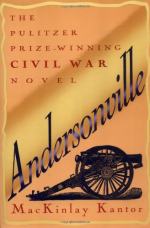Though the deaths were one thousand eight hundred and seventeen more than were killed at the battle of Shiloh—this left the number in the prison at the end of the month thirty-one thousand six hundred and seventy-eight. Let me assist the reader’s comprehension of the magnitude of this number by giving the population of a few important Cities, according to the census of 1870:
Cambridge, Mass 89,639
Charleston, S. C. 48,958
Columbus, O. 31,274
Dayton, O. 30,473
Fall River, Mass 26,766
Kansas City, Mo 32,260
The number of prisoners exceeded the whole number of men between the ages of eighteen and forty-five in several of the States and Territories in the Union. Here, for instance, are the returns for 1870, of men of military age in some portions of the country:
Arizona 5,157
Colorado 15,166
Dakota 5,301
Idaho 9,431
Montana 12,418
Nebraska 35,677
Nevada 24,762
New Hampshire 60,684
Oregon 23,959
Rhode Island 44,377
Vermont 62,450
West Virginia 6,832
It was more soldiers than could be raised to-day, under strong pressure, in either Alabama, Arizona, Arkansas, California, Colorado, Connecticut, Dakota, Delaware, District of Columbia, Florida, Idaho, Louisiana, Maine, Minnesota, Montana, Nebraska, Nevada, New Hampshire, New Medico, Oregon, Rhode Island, South Carolina, Utah, Vermont or West Virginia.
These thirty-one thousand six hundred and seventy-eight active young men, who were likely to find the confines of a State too narrow for them, were cooped up on thirteen acres of ground—less than a farmer gives for play-ground for a half dozen colts or a small flock of sheep. There was hardly room for all to lie down at night, and to walk a few hundred feet in any direction would require an hour’s patient threading of the mass of men and tents.
The weather became hotter and hotter; at midday the sand would burn the hand. The thin skins of fair and auburn-haired men blistered under the sun’s rays, and swelled up in great watery puffs, which soon became the breeding grounds of the hideous maggots, or the still more deadly gangrene. The loathsome swamp grew in rank offensiveness with every burning hour. The pestilence literally stalked at noon-day, and struck his victims down on every hand. One could not look a rod in any direction without seeing at least a dozen men in the last frightful stages of rotting Death.




